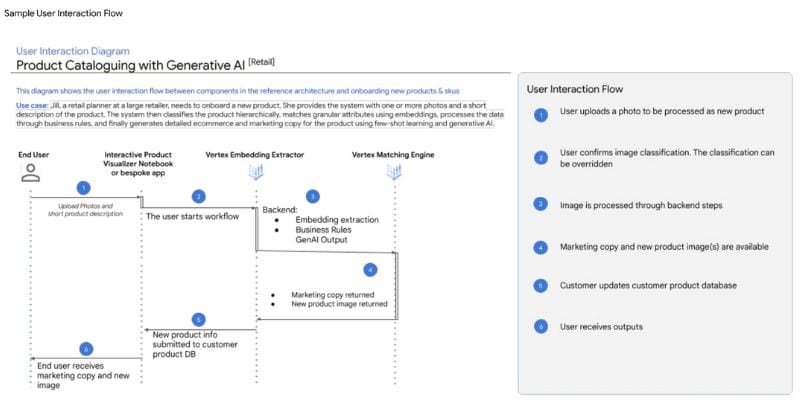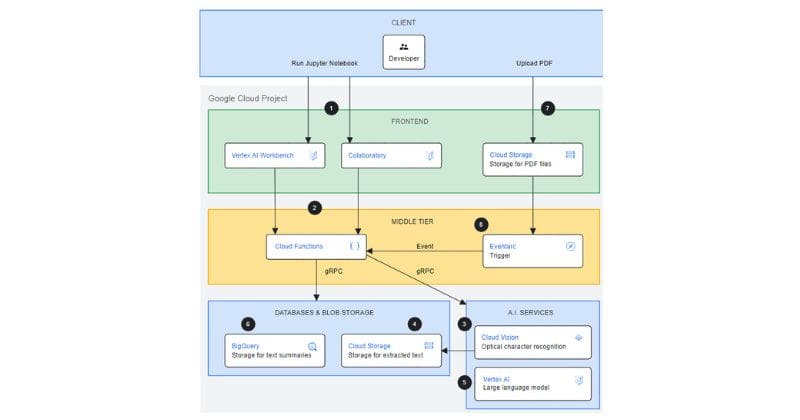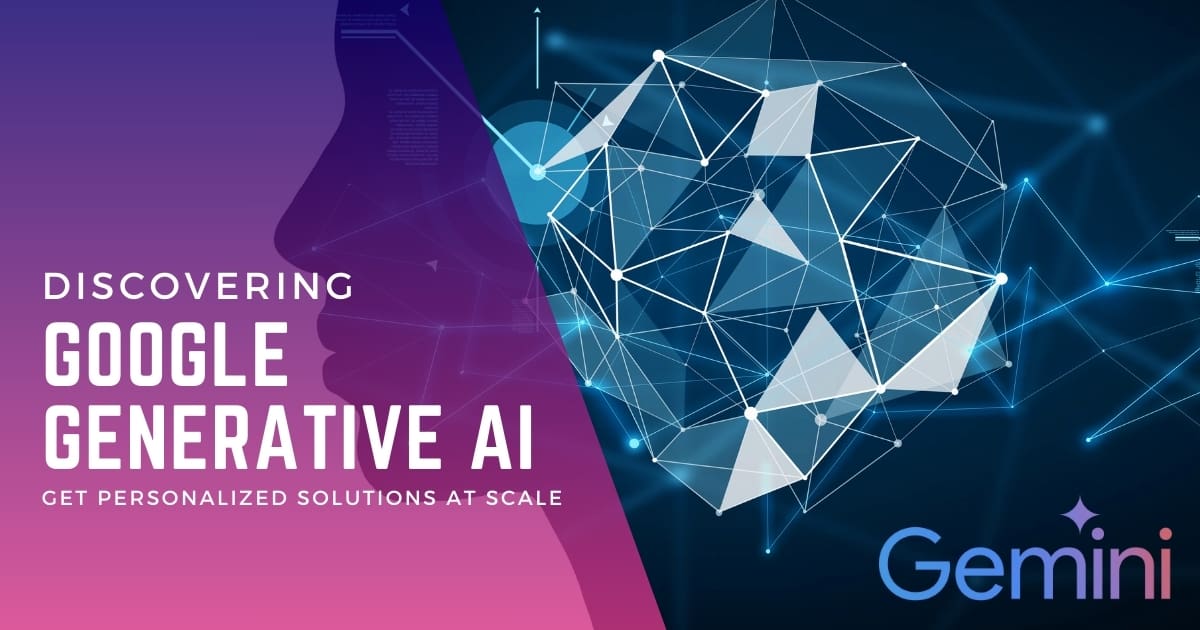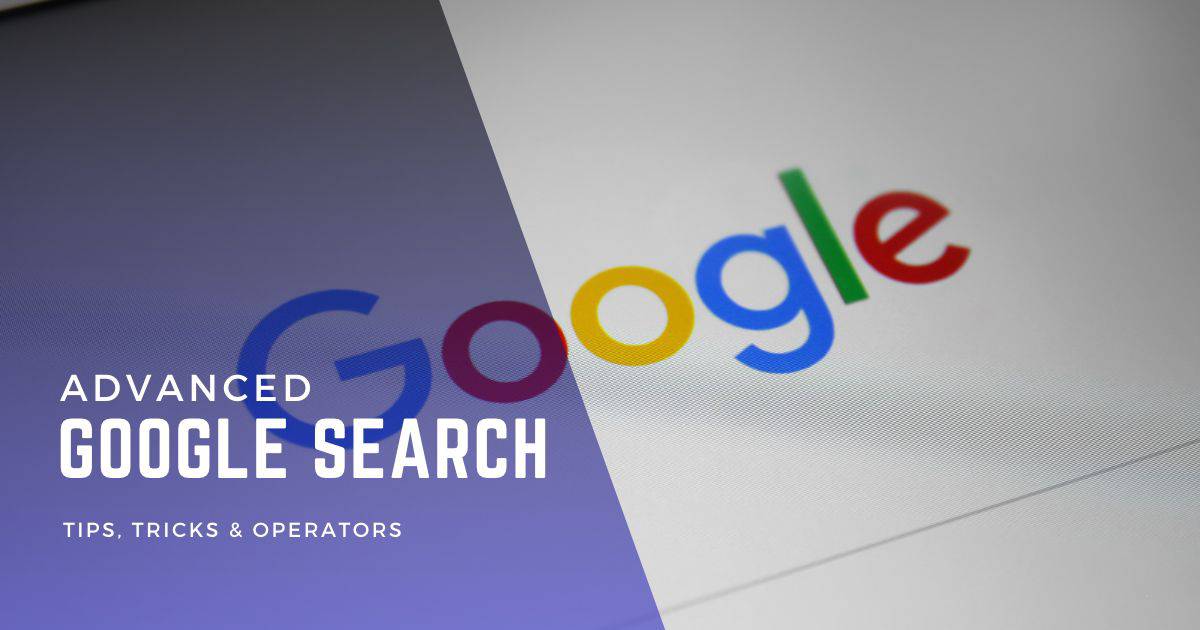Seeking to enhance your content with Google generative AI? Wondering how it can impact your blogging, marketing, or business growth?
Consistently producing engaging content is tough. Google generative AI offers a solution, simplifying content creation and making it more efficient.
Google generative AI can revolutionize your strategy, saving time and sparking creativity. It’s a game-changer for those looking to innovate and lead.
My experience in digital marketing and blogging has proven Google’s generative AI ability to boost content quality and engagement, driving growth.
What is Generative AI?
Generative AI, or generative artificial intelligence, is a subfield of AI that deals with creating new data, like text, images, or code. These models are trained on massive amounts of existing data, allowing them to learn the underlying patterns and relationships. They then use this knowledge to generate new, original data similar to the data they were trained on but not identical to.
This advanced system employs artificial intelligence algorithms to craft fresh and imaginative content autonomously. Google Generative AI generates original text, images, music, and more using deep learning methods. It mimics human-generated work seamlessly through the creation of diverse content types.
How Generative AI Works
The versatility of Google Generative AI shines across multiple industries like art, music, gaming, and advertising.
In virtual reality settings or video games, this technology crafts lifelike images for environments or characters seamlessly. Moreover in marketing campaigns tailored to individual preferences based on user data.
Applications of Generative AI
Generative AI is super useful in lots of areas. It helps artists make cool art and design stuff. In healthcare, it can make fake data for research or help find new drugs.
For businesses, it makes personalized ads for customers. Generative AI is awesome and can be used in many fields to be creative and solve problems better.
Google’s Role in Advancing Generative AI

Google Generative AI offers various benefits, such as increased productivity and enhanced creativity. It also leads to improved user experiences by generating innovative content.
However, challenges like ethical concerns, potential biases in generated content, and copyright issues must be addressed to ensure responsible use of this technology. Understanding the advantages and challenges of Google Generative AI is crucial for its ethical implementation.
Generative AI with Gemini
Google’s advancements in generative AI through projects like Gemini promise exciting future possibilities. Researchers are continuously working on enhancing natural language processing capabilities and improving the quality and diversity of generated content using innovative algorithms.
As technology progresses, we can anticipate even more sophisticated applications of Google Generative AI across different fields.
Pros:
- Increased productivity
- Enhanced creativity
- Improved user experiences
Cons:
- Ethical concerns
- Potential biases
- Copyright issues
Gemini Features Comparison
| Features | Pros | Cons | Differences |
|---|---|---|---|
| Creativity | – Boosts creative output – Generates unique ideas – Inspires new perspectives | – May not always align with user preferences – Requires input refinement for accuracy | Gemini focuses on enhancing creativity through AI-generated content |
| Productivity | – Speeds up content creation – Reduces writer’s block – Provides instant inspiration | – Content may need human touch-ups – Dependency on AI for ideas | Gemini aims to increase productivity by offering quick and efficient content generation |
Gemini Examples and Options
- Writing blog posts
- Generating social media captions
- Creating marketing copy
Gemini Steps and Instructions
- Open Gemini in Google AI Studio
- Select the type of content you want to generate
- Input any specific keywords or prompts
- Customize the length and tone of the content
- Review and edit the generated text as needed
Gemini in Google AI Studio is a powerful tool for enhancing creativity and productivity in content creation. With its unique features and user-friendly interface, users can easily generate a wide range of content, from blog posts to marketing copy, in minutes.
While it may not always be perfect, Gemini provides a valuable resource for writers looking to overcome creative blocks and streamline their workflow.
Enhancing Apps with Firebase
Google Generative AI is revolutionizing how digital content is created and consumed, offering vast potential applications across various industries. As this technology evolves, it becomes paramount to consider its ethical implications to ensure responsible usage practices carefully.
Integrating generative AI within Google Cloud signifies a significant step towards leveraging advanced technologies for diverse applications across industries. By incorporating generative AI into their Cloud services, Google opens up new avenues for innovation while addressing the complexities of utilizing such cutting-edge technologies.
- Vast potential applications across multiple industries.
- Need to consider ethical implications.
- Integration within Google Cloud for diverse application scenarios.
Studio Bot: AI-Powered Android Development Assistance
Studio Bot is revolutionizing Android development with its AI-powered assistance. This innovative tool provides developers with intelligent suggestions, code snippets, and optimizations to streamline the app development process.
By harnessing the power of artificial intelligence, Studio Bot helps developers save time, improve efficiency, and enhance the overall quality of their Android applications. With Studio Bot, developers can unlock new possibilities and take their projects to the next level.
Generative AI Integration in Google Cloud
Google Cloud has cool tech that helps businesses be better. You can make awesome stuff using generative AI tools in the cloud. It lets you be creative and think of new ideas. With Google Cloud, businesses can be ahead in the digital and tech.
Innovating with Generative AI in Google Workspace
Using Generative AI in Google Workspace can help you work better and faster. It uses AI to suggest responses in Gmail and Smart Compose in Google Docs.
This tech makes work easier and helps you create content quickly. With Generative AI, the future of work is smarter and more dynamic.
Optimizing Content Discovery and Personalization
Users can experience tailored recommendations based on their preferences. The AI can suggest relevant content by analyzing user behavior, such as search history and interactions. For instance, if a user frequently searches for healthy recipes, the AI might recommend cooking blogs or nutrition websites.
Personalizing Content Discovery with AI
Moreover, Google’s Generative AI enhances content personalization by understanding context and intent. When a user searches for “best hiking spots,” the AI lists locations and suggests related gear reviews or travel tips.
This level of personalized content discovery aims to improve user satisfaction and engagement by delivering precisely what they need.
- Tailored recommendations based on preferences
- Analysis of user behavior like search history
- Enhanced understanding of context and intent for personalized suggestions
Building AI-Powered Search Solutions
Building AI-powered search solutions using Google Generative AI enables businesses to offer advanced search capabilities on their platforms. By integrating this technology into their websites or applications, companies can provide users with more accurate results in less time. For example, an e-commerce website utilizing this AI could enhance its product search feature to show items similar to those viewed by the customer.
Implementing Google’s Generative AI in search solutions helps in semantic understanding. This means the technology comprehends keywords and their meaning, leading to more precise results. Businesses leveraging this capability can significantly improve customer experiences through faster access to relevant information.
- Advanced search capabilities for improved results
- Semantic understanding beyond keywords
- Enhanced customer experiences with quicker access to information
Product Catalog Enhancement with AI
Google Generative AI revolutionizes product onboarding and categorization, enabling businesses to automate adding new items to their catalogs. This innovation conserves time and effort previously spent on manual data entry and significantly diminishes the likelihood of human errors.

Advantages of AI in Product Management
The AI ensures uniformity throughout the catalog by accurately categorizing products based on their attributes. Such processing efficiency leads to real-time product listing updates, eliminating potential delays and enhancing the overall customer experience.
Creating Detailed Product Descriptions
Another significant aspect of leveraging Google Generative AI in enhancing product catalogs is creating detailed product descriptions automatically. This feature helps businesses swiftly generate engaging and informative content for each item in their inventory. For instance, an e-commerce platform can use generative AI to produce unique descriptions for thousands of products efficiently.
The ability to create detailed product descriptions at scale not only saves time but also enhances the overall customer experience by providing valuable information about each item. Moreover, with Google Generative AI, companies can ensure that their product listings are optimized for search engines, increasing visibility and driving more traffic to their online stores.
Content Creation and Prototyping
So, using Google Generative AI, content creation for marketing becomes streamlined and more impactful. This technology enables the production of new content that is both engaging and customized to meet the preferences of a target audience.
For example, a fashion brand could use AI to craft personalized product narratives that resonate with individual customer tastes.
Benefits and Considerations of AI in Marketing Content
Pros:
- Streamlines content creation, saving significant time.
- Allows for content customization to engage specific audience segments.
Cons:
- Potential loss of unique human creativity and nuance.
- Dependence on high-quality data for optimal outcomes.
AI’s role in marketing extends to generating a broad range of materials for various channels, including social media, web, and email, ensuring message consistency and adaptability. This technology not only enhances content relevance but also broadens audience reach.
Rapid Prototyping for Multi-Channel Marketing
Rapid prototyping plays a crucial role in testing different approaches quickly. With the help of Google Generative AI, marketers can prototype various versions of their campaigns efficiently before finalizing the strategy.
For example, an e-commerce company can test multiple ad copies simultaneously to determine which resonates best with its audience.
Steps for Rapid Prototyping:
- Identify key elements of the marketing campaign.
- Use Google Generative AI tools to create multiple variations.
- Analyze the performance metrics of each prototype.
- Refine and optimize the most successful version based on data insights.
- Rapid prototyping enables marketers to iterate swiftly and make data-driven decisions when developing multi-channel marketing initiatives using generated art performance from AI technology.
Research and Data Analysis
One of the advantages of utilizing Google generative AI for summarization is its ability to streamline large volumes of text quickly.
It enhances productivity by providing users with summarized content without compromising essential details. However, a potential drawback is the need for continuous refinement to ensure accurate and coherent summaries consistently.
Summarizing Complex Documents
When using Google generative AI to summarize complex documents, the focus shifts to efficiently extracting key information. This technology uses advanced reasoning to condense lengthy texts into concise summaries.
By leveraging datasets and innovative algorithms, it can swiftly identify critical points within a document. For instance, when analyzing a research paper on healthcare advancements, the AI can pinpoint and summarize breakthroughs succinctly.
Advancing Healthcare Data Search
Incorporating Google’s generative AI in advancing healthcare data search revolutionizes how medical professionals access crucial information rapidly. This technology facilitates more efficient exploration of vast medical databases by harnessing machine learning expertise. Imagine a scenario where doctors can input symptoms, and the AI swiftly retrieves relevant treatment options based on extensive healthcare datasets.
Using Google generative AI in healthcare data search offers unparalleled efficiency in retrieving vital medical information promptly. Medical teams benefit from quicker access to relevant data that aid in making informed decisions regarding patient care plans. Nonetheless, ensuring privacy and maintaining data security remain paramount when implementing such advanced technologies.
AI Assistance for Code Development
Google’s generative AI tools are revolutionizing how developers write code, offering AI assistance to streamline development. These tools help developers by providing suggestions, auto-completing code snippets, and even identifying bugs or errors in real time.
For example, developers stuck on a particular coding problem can rely on AI tools to suggest solutions based on patterns and best practices.
Enhancing Developer Productivity
By leveraging AI assistance, developers can significantly enhance their productivity. Instead of spending hours manually debugging or searching for syntax errors, these advanced tools can pinpoint issues and offer solutions promptly.
This saves time and allows developers to focus more on the creative aspects of coding rather than getting bogged down by repetitive tasks. With the continuous learning capabilities of generative AI models, these tools adapt to individual developer preferences over time, further improving efficiency.
Pros:
- Saves time by quickly identifying bugs
- Helps streamline the development process
- Encourages creativity by automating repetitive tasks
Cons:
- Dependency on AI assistance may hinder critical thinking skills
- Initial learning curve for adapting to new tools
Improving Efficiency with Code Models
- Use pre-trained models for common tasks
- Implement code generation tools
- Integrate code refactoring utilities
| Features | Pros | Cons |
|---|---|---|
| Streamlined development process | Faster coding | Steep learning curve |
| Error detection and correction | Improved accuracy | Initial setup time |
| Automated testing integration | Time-saving | Limited flexibility |
- Choose a code model that aligns with your project requirements
- Train your team on using the selected code model effectively
- Implement the code model into your development workflow
- Monitor the efficiency improvements and adjust as needed
Efficiency in coding is like having a well-oiled machine – it runs smoothly, gets the job done quickly, and requires minimal maintenance.
By utilizing code models, you can supercharge your development process, catch errors before they become problems, and automate tedious tasks. With the right tools and strategies, you’ll be coding faster and more accurately in no time.
Document Summarization
Document summarization, powered by Google Generative AI, revolutionizes how we distill vast texts into succinct insights. This advancement harnesses natural language processing (NLP) to pinpoint and extract the essence from extensive documents efficiently.

Automating Summarization for Quick Insights
Using Google Generative AI, shortening texts into concise versions becomes automated, offering rapid access to critical information. For instance, lengthy research papers can be condensed into essential points, facilitating quick comprehension.
The primary benefit of this technology lies in its time-saving capacity. It swiftly garners key details from texts, which is especially useful for individuals requiring a fast understanding of a document’s main ideas or conclusions.
Google Generative AI accelerates the summarization process and enhances accuracy and consistency, significantly reducing the chance of missing vital information. This efficiency allows users to allocate more time to analyze the summarized content, thereby boosting overall productivity.
Pros:
- Saves time by quickly extracting essential details
- Ensures consistency in summaries
- Enhances productivity by focusing on analyzed content
Cons:
- May overlook nuanced information present in lengthy texts
- Limited contextual understanding compared to human summarization techniques
Automated document summarization with Google Generative AI has proven instrumental across various fields such as research, journalism, and business intelligence due to its efficiency and accuracy in distilling complex information into concise summaries.
Final Thoughts
Google Generative AI offers significant benefits, impacting various fields by enabling automation, customization, and innovation. This technology helps businesses and creators by streamlining content creation and solving complex problems.
We’ve shared ways to leverage Google Generative AI to enhance your work. Your feedback is crucial; please comment with your views or experiences.
Look forward to more insights on Google Generative AI as we navigate the forefront of technological advancement.
FAQs
What is Google’s Generative AI?
Google’s Generative AI refers to advanced AI technologies developed by Google, leveraging large language models (LLMs) to predict text sequences and generate content. It is part of Google AI, focusing on creating new data from existing datasets.
How do I enable Google Generative AI?
To enable Google Generative AI, navigate to the Google homepage, access settings in the bottom right corner, select Search Settings and turn on the Google AI Search feature under the appropriate section.
What is Google AI called?
Google AI, or Google’s Artificial Intelligence, encompasses a broad range of AI technologies, including TensorFlow, natural language processing, computer vision algorithms, and voice recognition systems, developed to enhance machine learning and data analysis capabilities.
How do I use Generative AI in Google Docs?
To use Generative AI in Google Docs, open a document, click where you want to generate text, select “Help me write (Labs)” on the left, and input a prompt to guide the AI in generating content.



